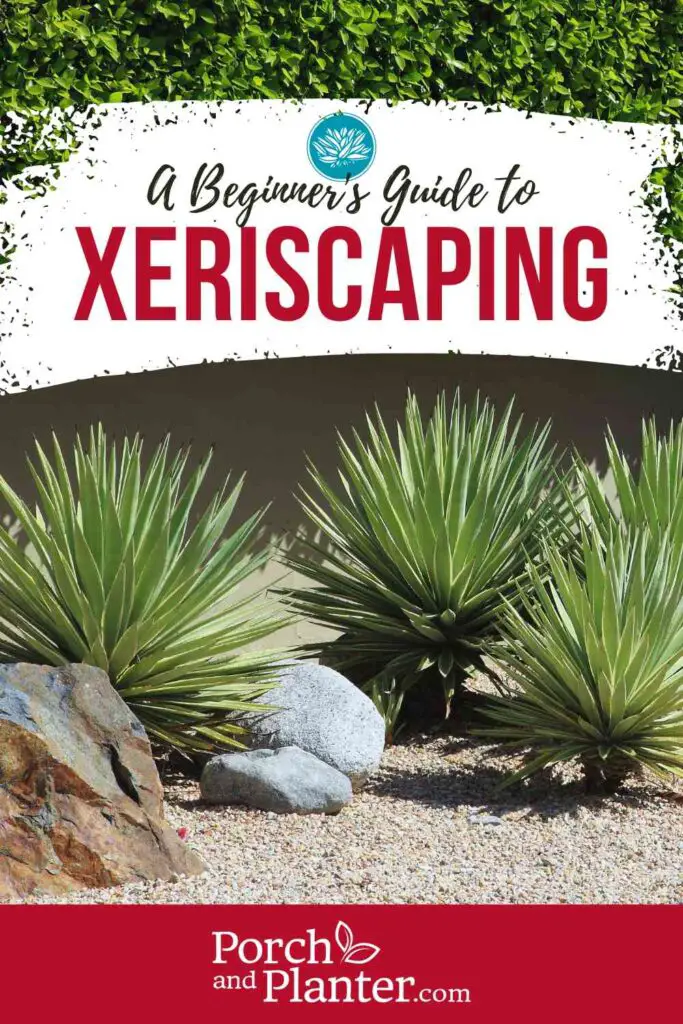A Beginner’s Guide to Xeriscaping

Xeriscaping is a sustainable landscaping technique that promotes water conservation and creates beautiful, low-maintenance landscapes. If you’re curious about xeriscaping and want to learn more, you’ve come to the right place! In this article, we’ll cover the basics of xeriscaping and answer common questions about how to start, what plants to use, water requirements, maintenance, challenges, costs, compatibility with other gardening techniques, and local regulations or incentives. Let’s dive in and explore the world of xeriscaping!
What Is Xeriscaping?
Xeriscaping is a landscaping approach that focuses on conserving water by using drought-tolerant plants, minimizing lawn areas, and utilizing efficient irrigation methods. The goal of xeriscaping is to create a sustainable landscape that requires minimal water input and maintenance, while still providing aesthetic appeal and functional use. Xeriscaping is not only environmentally friendly but also cost-effective in the long run, as it can reduce water usage and maintenance expenses.
How Do I Start Xeriscaping?
Starting xeriscaping involves careful planning and design. You’ll need to assess your site’s unique characteristics, such as soil type, sun exposure, and drainage, to determine the best approach. Consider factors such as plant selection, hardscapes, mulching, and irrigation methods to create a well-designed xeriscape that suits your specific location or climate. It’s important to plan ahead and have a clear vision of your desired outcome before implementing any changes.
Planning for Xeriscaping
Planning is a crucial step in xeriscaping. Before you start digging or planting, take the time to assess your site and its specific characteristics. Consider factors such as the amount of sunlight, wind patterns, soil type, and existing vegetation. Understanding these elements will help you make informed decisions about plant selection and irrigation methods.
Layout
When designing your xeriscape garden, think about the layout, focal points, and functional areas. Consider the aesthetics and functionality of your garden, and how it will blend with your home and surrounding environment. A well-thought-out plan will ensure that your xeriscape garden is not only beautiful but also practical and efficient.
Soil Preparation
You’ll also want to do a soil assessment. Based on the assessment of your site, you may need to add specific soil amendments to improve its structure, fertility, and water-holding capacity. Common soil amendments used in xeriscaping include compost, well-rotted manure, peat moss, and perlite. These organic and inorganic materials can be mixed into the existing soil to improve its texture, aeration, and nutrient content. It’s important to choose amendments that are appropriate for your soil type and the specific needs of your plants, and to follow recommended application rates for best results.
Timing is crucial when it comes to soil preparation in xeriscaping. It’s best to prepare the soil before planting, ideally several weeks or even months in advance. This allows the soil amendments to fully integrate and settle, creating an optimal growing environment for your plants. Depending on the climate and weather conditions in your region, you may need to plan ahead and prepare the soil during the appropriate season to ensure the best results. Avoid working with wet or frozen soil, as this can lead to compaction and damage to soil structure.
Water Saving Land Features
Proper management of water runoff is an important aspect of soil preparation in xeriscaping. By capturing and directing water where it is needed, you can maximize water use efficiency and prevent erosion. Consider incorporating swales, berms, or other drainage techniques in your xeriscape design to manage water runoff effectively. Swales, which are shallow ditches, can help slow down the flow of water and allow it to infiltrate into the soil, while berms, which are raised mounds of soil, can help prevent water from pooling and promote even distribution. These techniques can help you make the most of the water available in your garden and minimize water waste.
Irrigation
Efficient irrigation is a crucial aspect of xeriscaping, as it helps conserve water and ensure plants receive the right amount of moisture. When planning your xeriscape, consider choosing appropriate irrigation methods such as drip irrigation or micro-spray, and incorporate water-saving technologies like smart controllers, rain sensors, and soil moisture sensors. Grouping plants based on their water needs through hydrozoning can also help optimize water use. Additionally, consider rainwater harvesting as a sustainable practice to collect and store rainwater for irrigation. Efficient irrigation practices are essential for maintaining a healthy and sustainable xeriscape garden with minimal water use.
Choosing Plants for Xeriscaping
Selecting the right plants is crucial to the success of your xeriscape garden. Look for plants that are adapted to your region’s climate, soil type, and water availability. Drought-tolerant, native, and water-wise plants are ideal choices for xeriscaping as they are well-suited to the local environment and require minimal water once established.
Drought-tolerant plants are adapted to thrive in regions with limited water availability. They have specialized features, such as deep roots or waxy leaves, that help them conserve water and withstand dry conditions. Examples of drought-tolerant plants include succulents, such as cacti and agaves, as well as ornamental grasses and shrubs like lavender and Russian sage.
Native plants are naturally occurring species that are indigenous to a particular region. They are well-adapted to the local climate, soil, and wildlife, making them ideal for xeriscaping. Native plants typically require less water, fertilizer, and maintenance compared to non-native species. Research the native plant species in your area and choose those that are suitable for your xeriscape garden.
Water-wise plants are those that have low water requirements and are well-suited to xeriscaping. These plants are often selected for their ability to thrive in dry conditions without the need for frequent watering. Some examples of water-wise plants include yucca, sedum, and black-eyed Susan. Consult with local nurseries or gardening organizations for recommendations on water-wise plant species that are suitable for your region.
Watering in Xeriscaping
Efficient water use is a fundamental principle of xeriscaping. The goal is to minimize water waste and ensure that every drop counts. Proper watering practices are essential to maintaining a healthy and thriving xeriscape garden while conserving water.
One of the key principles of watering in xeriscaping is to water deeply and less frequently. This encourages plants to develop deep root systems, which helps them access water from lower levels of the soil and become more drought-tolerant. Shallow and frequent watering, on the other hand, promotes shallow root growth and can make plants more susceptible to drought stress.
Drip irrigation or soaker hoses are highly recommended for xeriscaping as they deliver water directly to the plants’ root zones, minimizing water loss from evaporation or runoff. They are also more efficient in water use compared to overhead sprinklers, which can lose a significant amount of water to evaporation and wind drift.
It’s important to water your xeriscape garden based on the specific needs of the plants and the weather conditions in your region. Avoid watering on a fixed schedule and instead, monitor the moisture level of the soil regularly. Water only when the soil is dry to a certain depth, usually 1-2 inches, depending on the type of plants and soil conditions. This encourages plants to develop deeper roots and become more resilient to drought.
Incorporating a rain sensor or a smart irrigation controller into your xeriscape garden can also help optimize water use. These devices can automatically adjust the irrigation schedule based on weather conditions, such as rainfall or high humidity, to prevent overwatering.
Mulching is an effective technique in xeriscaping to reduce water evaporation from the soil surface and help retain moisture. It’s also really easy to do. Simply apply a layer of organic mulch, such as wood chips or shredded bark, around the base of plants, leaving some space around the stems to prevent moisture-related issues.
Maintenance in Xeriscaping
Proper maintenance is essential to keep your xeriscape garden healthy and thriving. Although xeriscaping requires less maintenance compared to traditional gardens, there are still some key tasks that need to be done to ensure the long-term success of your water-wise landscape.
Weeding
Weeding is an important maintenance task in xeriscaping to prevent weeds from competing with your plants for water and nutrients. Regularly inspect your garden for weeds and remove them promptly to prevent them from establishing and spreading. Mulching can also help suppress weed growth and reduce the need for frequent weeding.
Pruning
Pruning is another important maintenance task in xeriscaping to maintain the shape, size, and health of your plants. Prune dead or diseased branches, and remove any overgrowth that may be shading other plants or obstructing pathways. Pruning also encourages bushier growth and enhances the aesthetic appeal of your xeriscape garden.
Fertilizing
Fertilizing is generally not required as frequently in xeriscaping compared to traditional gardens, as native and drought-tolerant plants are adapted to low-nutrient soils. However, if you notice signs of nutrient deficiency in your plants, such as yellowing leaves or poor growth, you may need to apply a slow-release, low-phosphorus fertilizer sparingly.
Monitoring Moisture Levels
Monitoring the moisture level of the soil and adjusting your watering schedule accordingly is an ongoing maintenance task in xeriscaping. Regularly check the moisture level of the soil, and water only when the soil is dry to a certain depth, as mentioned earlier. Avoid overwatering, as it can lead to root rot and other moisture-related issues.
Controlling Pests
Finally, keep an eye out for pests and diseases in your xeriscape garden and take appropriate measures to control them. Use organic or chemical pesticides sparingly and only when necessary, and choose pest-resistant plant species whenever possible to minimize the need for pest control.
Benefits of Xeriscaping
Xeriscaping offers numerous benefits, making it an attractive option for homeowners and landscapers alike. Some of the key benefits of xeriscaping include:
- Water conservation: Xeriscaping significantly reduces water use compared to traditional landscaping, making it an environmentally-friendly choice. By using native and drought-tolerant plants, optimizing watering practices, and reducing water loss through techniques like mulching, xeriscaping can save a significant amount of water and help conserve this precious resource, especially in regions with limited water availability or during times of drought.
- Cost-effective: While the initial investment in xeriscaping may be higher due to the use of drought-tolerant plants and other water-saving technologies, the long-term cost of maintenance and water use is typically lower compared to traditional landscaping. With reduced water bills, lower maintenance requirements, and fewer pest and disease issues, xeriscaping can result in cost savings over time.
- Low maintenance: Xeriscaping is designed to be low-maintenance, as it uses plants that are adapted to the local climate and require minimal care. Native and drought-tolerant plants are well-suited to the local conditions, which means they are more likely to thrive without the need for frequent watering, fertilizing, or pest control. This can save homeowners time, effort, and money in ongoing maintenance tasks.
- Increased property value: Xeriscaping can enhance the value of your property. As water conservation and sustainability become more important considerations for homeowners and buyers, a well-designed and properly maintained xeriscape garden can be an attractive feature that adds value to your property.
- Environmental benefits: Xeriscaping has several environmental benefits beyond water conservation. By using native and drought-tolerant plants, xeriscaping promotes biodiversity and supports local wildlife, including birds, bees, and butterflies. Additionally, xeriscaping reduces the need for chemical fertilizers, pesticides, and herbicides, which can have negative impacts on the environment and human health.
- Aesthetically pleasing: Xeriscape gardens can be just as beautiful and visually appealing as traditional gardens. With careful plant selection, thoughtful design, and proper maintenance, xeriscaping can create a stunning landscape that is visually pleasing, functional, and environmentally responsible. Xeriscape gardens can feature a variety of textures, colors, and seasonal interest, providing year-round beauty and enjoyment.
- Drought tolerance: One of the key benefits of xeriscaping is its ability to withstand periods of drought. By using drought-tolerant plants and implementing water-saving techniques, xeriscaped gardens are better able to survive and thrive during dry spells or water restrictions, making them a resilient landscaping option for regions prone to drought or water scarcity.
Conclusion
In conclusion, xeriscaping is a sustainable and water-wise landscaping approach that offers numerous benefits, including water conservation, cost-effectiveness, low maintenance, increased property value, environmental benefits, aesthetic appeal, and drought tolerance. By incorporating native and drought-tolerant plants, optimizing watering practices, and practicing proper maintenance, you can create a beautiful and sustainable xeriscape garden that is both functional and environmentally responsible.



